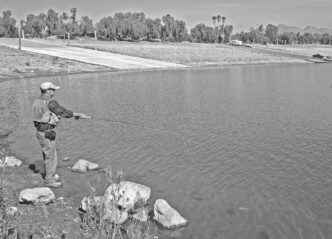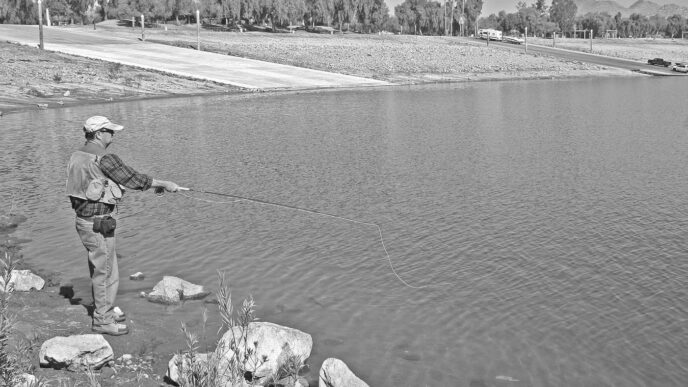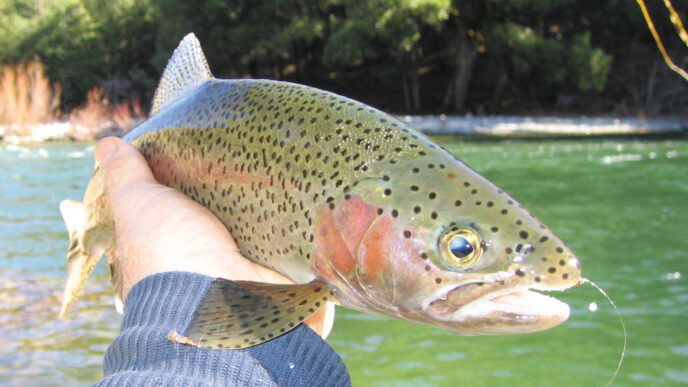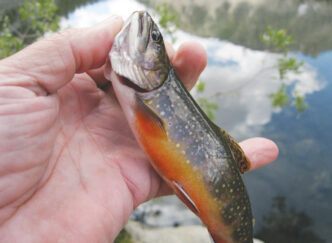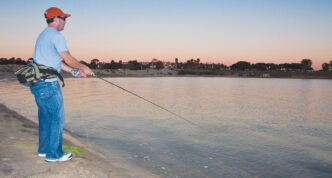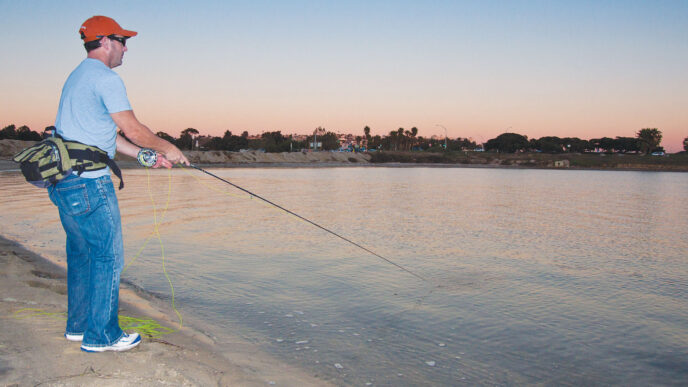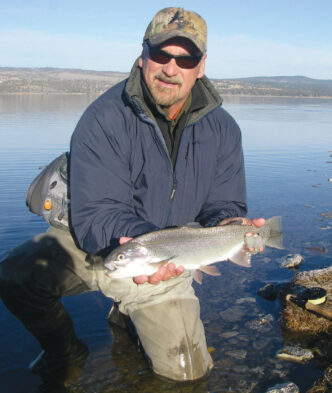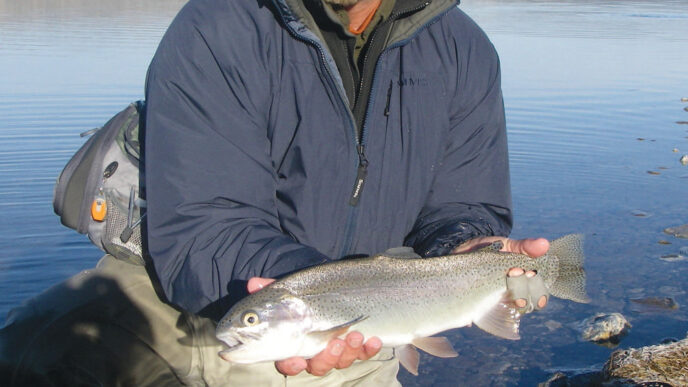I have always had a fascination for any story, historic place, and artifact relating to our country’s westward migration. I have collected books and spent countless hours in libraries and used book stores chasing the sounds of the wagons.
This past season, I had occasion on a number of fishing trips to follow portions of several immigrant trails. Once was with fishing friend Joe Byrne and members of the Nevada County Land Trust. We went a number of miles through six or seven locked gates and rendezvoused at Garden Bar on the Bear River, above Camp Far West Reservoir. This is a special property that deserves preserving, It is near where the trail that came over Donner Pass emerged out of the Sierra foothills onto the Sacramento Valley floor after the arduous crossing of the Sierra crest. It was a place to rest the weary, both human and livestock, less than a week’s march from Sutter’s Fort.
A second experience was in the Truckee River drainage. I was told and I confirmed with a walk that an immigrant trail crossed the Little Truckee above Boyington Mill Campground and moved west up Prosser Creek toward Alder Creek, of Donner Party fame. It heads through a low swale where the river runs west and again north in the lower part of the valley below Stampede Reservoir. What storied history lies still untold in that basin and the canyons of the Truckee?
A third encounter was in my backyard, so to speak. I was on the way to fish Fuller Lake, off Highway 20, and decided to pull out to walk and explore ruts of the trail that I had passed many times when the excitement and urgency of a fishing adventure didn’t allow time for a stop. You can follow it for miles and find sections in Bear Valley, where Highway 20 dips and then rises toward Highway 80 at Yuba Gap. Another discovery was along the Oregon Trail in eastern Oregon. My fishing partner and I were on our way to fish the Owyhee River, not far from the Idaho border, and stumbled on an interpretive site along a deserted rural road. We were able to walk a section of the trail that wound uphill toward a low pass through sagebrush and high, waving grass. We followed the ruts made by the wagon wheels. You could close your eyes and hear the wagons creaking and oxen groaning as they pulled a line of prairie schooners toward the crest.
Farther down that bumpy road, on a grassy plain adjacent to a high, muddy Owyhee, we encountered a Mormon reenactment of one of their westward treks. Immense, hand-pulled carts were circled on a flat adjacent to and above the river. Men, women, and children dressed in homespun worked at camp chores and the preparation of the evening meal. We walked among the friendly group and marveled at the meals that were coming from open campfires and Dutch ovens. We were invited to stay, but we begged off, because we had a rendezvous a few miles upriver with Steve Cooper, our fishing guide. Our own encampment was not so elaborate, but Steve cooked a notable tri-tip on a grill above coals from winter driftwood that we gleaned from low branches in the cottonwoods that surrounded our camp. After a sumptuous dinner and a few glasses of wine, a question arose in campfire chatter . . . what did the immigrants eat?
Contrary to some claims, immigrants did not live off the land. Provisions bought at the jumping-off point in St. Joseph, Missouri, and along the trail at forts and outposts were the basis of their survival on a journey of four to six months across the plains and Rockies and finally over the Sierra or the Cascades. Hundreds of pounds of flour, salt, coffee, beans, rice, bacon, butter, dried apples, cornmeal, hardtack, and crackers allowed our forefathers to survive the crossing. If it were possible to pick out one item of importance, it might be flour. Carried in barrels or double-layer sacks, it could be baked as bread, made into dough that was fried, baked in cakes, pies, and biscuits, and used as thickening in stews. Reprovisioning opportunities diminished as the wagons rolled west and as prices at the remaining outposts and forts rose.
The immigrants did supplement their provisions with whatever they could forage. Woe to wild animals that crossed their path. Deer, antelope, bison, squirrels, rabbits, prairie hens, curlews, snipes, plovers, and ducks fell to the guns of opportunistic pilgrims. One immigrant wife wrote home that “I have eaten enough rabbit in one year for a lifetime.” George L. Curry wrote in 1846: “We supped last night on curlew, snipe, plover and duck — that’s prairie bill of fare for you! Don’t your mouths water? — but they need not, if you let your minds take in the idea of the number of mornings and nights that plain middling meat, crackers and heavy biscuit comprise our fare.”
The travelers caught fish as opportunity provided, but many immigrants came from urban environments and didn’t have the necessary skills. If they did, the best bait was said to be grasshoppers. In river bottoms and on moist hillsides, our Argonauts gleaned wild onions, herbs, greens, and berries, but there wasn’t much time for foraging, and straying from the trail or wagons wasn’t always a healthy endeavor.
Pioneers were painfully aware of scurvy, the sailor’s disease, and sought relief by bringing dried fruits or hard-to-get lemons. Some thought pickled vegetables helped, but in fact, pickling destroys the vitamin C that prevents the disease. Those wild onions, herbs, and anything else green, such as a mustard greens, wild chives, garlic, strawberries, or dandelions were a blessing in this regard, and they helped to break up the monotony of bread, salt pork, and beans.
The travelers did their baking in Dutch ovens, covered iron skillets, or even in trenches and small caves. It was a challenge to get bread to rise. They carried sourdough starters in crocks that swung from the wagons. A product called salaterus, bought in tins, was a substitute for baking powder. Making a cake without eggs challenged the most creative cook, but dried apples and a pinch of hoarded cinnamon could make a cake for a treat. If an immigrant had a cow, milk and butter churned into little balls by the bumpy ride gave them essential ingredients.
They roasted animals on iron spits and fried meat in pans or tenderized it in stews. Meat that wasn’t consumed was spiced and “jerked” into long, thin strips and hung over ropes to dry. Never mind dust, sand, insects, and vermin. Those hard, tooth-cracking strips could save the day weeks later.
When making camp, pioneers needed time to gather wood, build a fire, and get a meal together. Sometimes the travelers did the heavy cooking late into the night or at a “nooner,” when the wagons stopped several hours to rest the cattle and travelers alike. A layover at a good camp gave a longer rest and the opportunity to prepare food for several days. The finished product might be eaten cold when the wagons stopped at night.
A dreaded occurrence was the “dry camp,” with no access to water. Equally calamitous was hail, lightning, and drenching rain, which challenged even trailwise cooks. One account tells of taking 45 minutes to get a fire going. Dysentery and even cholera struck down travelers who drank from tainted water supplies. A good camp had three essentials; water, fuel, and grass, but the quality of any of them was never guaranteed.
Between 1840 and 1860, nearly three hundred thousand men, women, and children made the trek westward. Fifty thousand were on the road in 1850. Not all survived. Misery and despair were trail companions. The route got progressively more difficult, and it was harder and harder to find fuel nearby. Most burnable cellulose had been gleaned by earlier parties, and many parts of the routes had sparse vegetation. Some sections of the trails were braided ribbons because the drivers spread out to lessen the terrible dust and to have a better chance at finding wood to burn and grass for cattle. Green willows, sagebrush, and greasewood often provided smoky heat. Buffalo chips were a godsend when nothing else could be found for fuel.
Those who came west in wagons were creative cooks. They worked with what they had. Men women and children were resourceful and used Yankee ingenuity in preparing meals. Necessity often dictated that an evening meal in a dry camp might be nothing more than hardtack biscuits and coffee, but they could whip up an apple pie on the Fourth of July and even make a crude ice cream using snow at South Pass. A good meal, then and today, was more than sustenance. It could spice a special occasion and lift weary spirits.
That meal and campfire talk on the Owyhee and on other nights near the Truckee rekindled a vow to try and duplicate some of the immigrant’s culinary feats at home during the fishing and camping season. I actually started a year ago November. First I needed authentic fuel. I remembered a bison ranch farther down the road that leads to my home. A crusty foreman who ran the beautiful spread (it has a 10-acre bass pond and harbors wild pheasants) for the absentee owners shrugged his shoulders at my request and let me into a vacant pasture. You don’t want to challenge full-grown bison in any way. I scooped up two trash bags full of dark, soggy bison field pies. The old foreman was muttering under his breath as I lugged the heavy load to my truck.
My pies were drying fine in the late spring under a barn overhang, but mysteriously disappeared. A search found them scattered on a wet burn pile . . . thrown there by an overzealous worker who was doing spring weed and fire-safety cleanup. Never mind — it rained on the prairie, too. I read that the best chips had seen several seasons out there.
Our experiment in late 2011 started off on the wrong foot. I couldn’t get a one-year-old Nevada County buffalo chip to burn . . . even using a propane torch. A postmortem suggested that bison chips of the prairie came from animals eating perennial prairie grass four to six feet high, grass that is now largely extinct, except in preserves. My neighbor’s bison had grazed on Mediterranean annuals and had received hay and other supplemental feeds. Sometimes you can’t go back. Even grassfed, free-range steer isn’t the same. Nor does a free-range chicken taste quite like a prairie hen, which has just a hint of wild sage.
My wife and I were going to grill some buffalo New York steaks on the chips and bake a cake in an antique Dutch oven that came from a 125-year-old ranch near Auburn. I quickly dug a small slit trench and started a fire with blown-down pieces of black oak, which made fine coals. Our meal was successful, and we are going to do more elaborate meals in the pioneer fashion using some of the old recipes, both at home and out camping along the river.
I Googled “wagon train reenactments” and found a number throughout the West. One is along the American River and Highway 50 on the way to Placerville, another at Applegate, in Oregon. There’s lots of fishing nearby, and the experience will add to our knowledge. The campfire ambience should be great. On my next trip to the Little Truckee, I’m going to stop at Donner Lake State Park for another look at the Donner Party Memorial . . . if it isn’t closed due to lack of funds. As I was writing this column, my wife found a DVD of a film titled Meek’s Cutoff. It won many film festival awards both here and abroad and was filmed near the Malheur National Wildlife Refuge in eastern Oregon. It tells the story of a small, three-wagon party that took a shortcut and lost their way in the wilderness. The incident rang a bell with us. We’ve fished Mann Lake on the other side of Steens Mountain and explored that desolate area. The film was so authentic and engrossing that we watched the “special features” section on a second night. Take a look if you want to get a glimpse of what the life on on wagon train was really like. The cinematography and authenticity are excellent. We plan on camping next summer at
Davis Lake and Frenchman’s Reservoir and at Boyington Mill on the Little Truckee near that wagon trail. I’ll be glad to share some wild berry cobbler from our Dutch oven and even a fishing tale or two. When it gets late, and the last campfire ember is doused, you might even hear those wagons rolling by.
Virginia Reed, a 13-year-old Donner Party survivor, wrote about her Fourth of July on the trail: “We selabrated the 4 of July on plat (Platte River) at Bever criek severl of the Gentlemen in Springfield gave paw a botel of licker and said it shoulden be opened till the 4 day of July and paw was to look to the east and drink it and they was to look to the West an drink it at 12 o’clock paw treted the company and we all had some lemminade, maw and paw is well.”
Café Maddalena
Reviewed by Andrew Kubersky
Every fishing trip is a vacation, and for me, every vacation begins as soon as I pack my stuff. When we pull away from the curb, I am somewhere else immediately and entirely. My mind and soul have been transported already, but they reside in the body of a mammal that requires food fairly frequently, and my nature always seeks food that is not only good, but special and even memorable.
Then I remember — my route takes me through the Great American Culinary Desert, that vast wasteland of fast food, questionable ingredients, and serving staffs that have no idea what those ingredients are. Thankfully, there are exceptions — more and more of them as we slowly become more food conscious as a nation. One of these exceptions, a restaurant in the old railroad town of Dunsmuir along the upper Sacramento River, a river that is also a blue-ribbon angling destination, is Café Maddalena.
When we exited the freeway and entered Dunsmuir from the south, my well-traveled companion averred, “If this were a town in the French countryside, we would be able to find a great bistro or café. There is all too little of this opportunity in the United States.” I told him I had something in mind that might be a pleasant surprise.
Café Maddalena was opened in 1993 by Maddalena Serra, a former line cook and pastry chef at both the Washington Square Bar and Grill and Splendido in San Francisco. The plan was to cater to anglers coming to the area. Things don’t always work out, and two years later, Ms. Serra and her husband decided they couldn’t make a go of it and put the business up for sale. She operated it for a long time before a buyer could be located. The buyers turned out to be Brett LaMott and his wife, Nancy Ratzesberger.
Chef LaMott has a background that includes working in San Francisco’s venerable Amelio’s, where he studied under Jacky Robert, and Ernie’s, which had epitomized the classic San Francisco dining scene for about four decades until its closing in 1995. The closure of Ernie’s freed LaMott to pursue his dream of a country restaurant, and he and his wife purchased Café Maddalena in the late 1990s. They have been operating the business ever since under its original name. While anglers and other tourists are still warmly welcomed, LaMott turned the focus to a local orientation to gain patronage from the Dunsmuir community and the repeat business that can and does come from that.
Upon entering the restaurant, one feels the warm ambience of the rustic, wood-paneled dining room and small wine bar. There is an open kitchen overlooking the dining room.
The food served at Maddalena is heavily influenced by Mediterranean cuisine. A menu of bistro-inspired dishes from southern France and northern Spain, including Languedoc, the Basque Country, Extremadura, and Catalonia, changes weekly and concentrates on seasonal availability. The restaurant is committed to locally sourced products and to sustainably produced ingredients. Our server, Richard, was warm and professional and knew all of the dishes, the ingredients, and the wine list. My appetizer was spot prawns sautéed with garlic, lemon, white wine, some chili flakes, and parsley. It is a dish I’ve had many times in many places, including in my own house. This was as good as I’ve had. The prawns were fresh and tender. It’s not a complicated dish, but it was very well executed.
As an entrée, I had one of the nightly specials, a pot roast made from brisket of beef from a local cattle ranch. It was braised with wine, grapes that were almost raisins, and verjus. (Not as acidic as vinegar, verjus is made from the pressed juice of unripened grapes.) The flavors were well developed, as only the flavors of a braise can be. It was a fine example of comfort food. I loved it.
My friend enjoyed his roasted beet salad appetizer and pasta with fresh chanterelles. (The fall of 2011 has been a very good chanterelle season in Northern California.) If a dish has chanterelles in it, my friend Dick will order it, and he, too, was well pleased with his choices.
I was impressed with the wine list, composed primarily of Spanish, French, and Italian bottles priced between $18 and $42 each. These prices represented a miniscule markup by today’s standards. The list changes regularly.
Operating a small restaurant in a small community is hard work. It has to be something that you want to do, something for which you have a real passion. The days are long and profits are hard to come by. Customers can be difficult to please. A friend who operates the Cachagua General Store, a restaurant deep in the Carmel Valley, told this story recently. “We had a standing rib roast of pork on the menu — like a prime rib, only pork. Roasted boneon, it was cut off the bones for serving. I sliced a big pile. But the customer sent back the plate. It was not standing! Jesus wept.”
Why do chefs do what they do, with so little reward? Again, it is the passion and the commitment. Thankfully, there are a few chefs who make a dining sojourn during that drive through the Great American Culinary Desert a genuine pleasure. And “dining” is different from “eating.”
Café Maddalena, 5801 Sacramento Avenue, Dunsmuir, CA 96025, (530) 235-2725, http://www.cafemaddalena.com.






